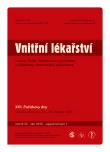Heparin-induced thrombocytopenia in children threated with low-molecular weight heparins. Is there any reason to misgiving?
Authors:
O. Zapletal 1; J. Blatný 1; J. Štarha 2
Authors‘ workplace:
Oddělení klinické hematologie FN Brno, Dětská nemocnice, Centrum pro trombózu a hemostázu, primář prof. MUDr. Miroslav Penka, CSc.
1; Pediatrická klinika Lékařské fakulty MU a FN Brno, Dětská nemocnice, přednosta prof. MUDr. Zdeněk Doležel, CSc.
2
Published in:
Vnitř Lék 2010; 56(Supplementum 1): 55-57
Category:
16th Parizek's Days, Ostrava-Poruba, March 25th –26th 2010
Overview
Heparin-induced thrombocytopenia (HIT) is relatively common adverse event of the treatment with heparins. Authors review available published data on ethiology, epidemiology, diagnostics, clinical findings and treatment options of HIT in general, but also point out certain specific issues related to HIT in children. We also present a case report of 5 - month old infant with primary diagnosis of short bowel syndrome, who developed HIT. We do confirm that HIT is rare complication of heparin treatment in children. Incidence of HIT is smaller when using low molecular weight heparin (LMWH) than unfractioned heparin (UFH). Nevertheless HIT should be always considered within differential diagnosis in the child with thrombocytopenia treated with heparins and/ or in case of poor therapeutic response (or even progression) of thrombosis in such a patient.
Key words:
heparin-induced thrombocytopenia – children – heparin
Sources
1. Arepally GM. Nothing typical about HIT. Blood 2009; 113 : 4825 – 4826.
2. Warkentin TE, Sheppard JI, Moore JC et al. Studies of the immune response in heparin-induced thrombocytopenia. Blood 2009; 113 : 4963 – 4969.
3. Andrew M, Monagle PT, Brooker L. Thromboembolic complications during infancy and childhood. Toronto: University of Toronto Press 2000, 299 – 301.
4. Greinacher A, Kohlmann T, Strobel U et al. The temporal profile of the anti-PF4/ heparin immune response. Blood 2009; 113 : 4970 – 4976.
5. Hirsch J. Guidelines for Antithrombotic Therapy. Hamilton, Canada: BD Decker Inc 2008, 44 – 51.
6. Warkentin TE. The paradox of heparin-induced thrombocytopenia. J Thromb Haemost 2009; 7 : 1472 – 1473.
7. Tardy - Poncet B, Piot M, Chapelle C et al. Thrombin generation and heparin-induced thrombocytopenia. J Thromb Haemost 2009; 7 : 1474 – 1481.
8. Magnani HN, Gallus A. Heparin-inducedthrombocytopenia (HIT). A report of 1,478 cli-nical outcomes of patients treated with danaparoid (Orgaran) from 1985 to mid - 2004.Thromb Haemost 2006; 95 : 967 – 981.
9. Spadone D, Clark F, James E et al. Heparin-induced thrombocytopenia in the newborn. J Vasc Surg 1992; 15 : 306 – 311.
10. Klenner AF, Lubenow N, Raschke R et al. Heparin-induced thrombocytopenia in children: 12 new cases and review of the literature. Thromb Haemost 2004; 91 : 719 – 724.
11. Bidlingmaier Ch, Magnani HN, Girisch M et al. Safety and efficacy of Danaparoid (Orgaran®) use in children. Acta Haematologica 2006; 115 : 237 – 247.
Labels
Diabetology Endocrinology Internal medicineArticle was published in
Internal Medicine

2010 Issue Supplementum 1
Most read in this issue
- Thrombocytopenia and coagulopathy in hepatopathy: an introduction into the issue
- Monitoring of coagulation parameters and options to influence them in patients with liver cirrhosis prior to invasive procedures
- Differential diagnosis of thrombocytopaenia in pregnancy
- The application of IPF (Immature platelet fraction) in laboratory diagnostics
